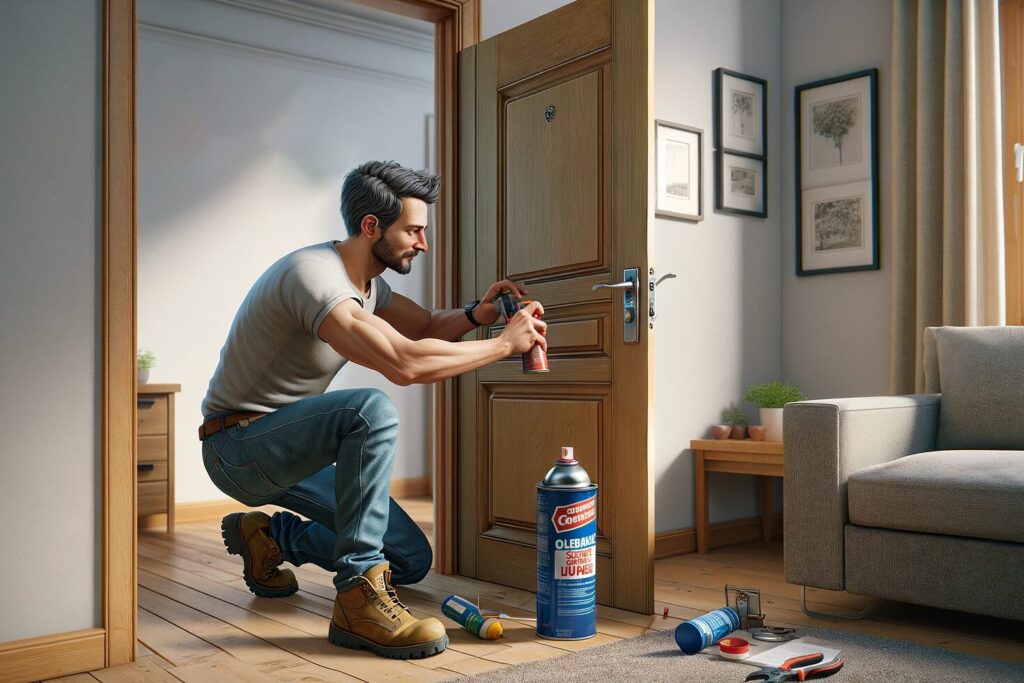Welcome to the world of home improvement, where even the smallest fix can make a world of difference. Today, we’re tackling a common yet often overlooked issue in many homes and buildings – the squeaky door hinge. It’s a problem that might seem trivial, but it can be a real annoyance, much like a leaky faucet or a creaky floorboard. This guide is crafted for both the savvy home handyman and the seasoned construction professional in the USA. Let’s get into the nuts and bolts of fixing those pesky squeaks.

Understanding Squeaky Hinges
First off, let’s understand the culprit behind that irritating noise. Squeaky door hinges are usually the result of friction caused by wear and tear, lack of proper lubrication, or the buildup of dirt and grime. These hinges, whether they’re the common butt hinge or the more complex ball-bearing variety, are made from a range of materials like steel, brass, or even stainless steel. The type of hinge and its material can greatly influence the approach to fixing the squeak.
Tools and Materials Needed
Now, onto the tools and materials you’ll need to tackle this job. It’s like gathering your ingredients before baking a cake – preparation is key. Here’s what you should have on hand:
- Screwdriver: Choose the right type (Phillips or flat-head) to match your hinge screws.
- Lubricants: WD-40 is a classic choice, but for longevity, consider silicone-based lubricants or white lithium grease.
- Clean Cloths: Essential for keeping the work area and hinge clean.
- Steel Wool or Sandpaper (optional): Ideal for addressing any rust issues.
- Hammer (sometimes necessary): For carefully re-seating the hinge pin.
- Needle-nose Pliers: These will help you grip and adjust the hinge pin with precision.
When picking out these tools, consider the type of hinge you’re working with. For painted hinges, be mindful to avoid chipping the paint. For interior doors, a silicone-based lubricant is a great option as it doesn’t attract much dirt. On the other hand, for exterior hinges that face the harsh outdoor environment, a robust option like white lithium grease might be more appropriate.
By understanding the nature of the problem and preparing the right tools and materials, you’re setting yourself up for a successful and satisfying fix. Let’s move on to the step-by-step guide, where I’ll show you how to turn that annoying squeak into a thing of the past.

Step-by-Step Guide to Fixing Squeaky Hinges
Let’s get hands-on with a practical approach to quieting those pesky squeaky hinges. This process, honed over years of experience, is designed to be straightforward and effective.
- Identifying the Squeaky Hinge: The first step is akin to playing detective. Open and close the door to zero in on the offending hinge. It’s crucial to identify the right one to ensure an efficient fix.
- Tightening the Screws: Often, a simple tightening of the hinge screws is all that’s needed. Use the correct screwdriver to snugly tighten each screw. Remember, the goal is firmness, not stripping the screw heads.
- Cleaning the Hinge: If the squeak persists, move on to cleaning. Gently wipe down the hinge with a cloth. If rust or dirt is present, lightly scrub with steel wool or fine-grit sandpaper. This step is about cleaning, not removing the hinge’s finish.
- Lubricating the Hinge: Lubrication is key. Apply a suitable lubricant (WD-40, silicone spray, or white lithium grease) directly onto the hinge, ensuring coverage of the moving parts. Operate the hinge a few times to work the lubricant in, then wipe away any excess.
- Testing and Adjusting: Test the door by opening and closing it. If the squeak remains, reapply lubricant and test again. Patience is essential here, sometimes the lubricant needs a bit of time to fully penetrate.
- Repeat for Other Hinges: If other hinges are squeaky, repeat these steps. Systematic application ensures a comprehensive solution.

Prevention Strategies
Preventive maintenance is the cornerstone of long-lasting hinge functionality. These strategies, based on years of experience, are straightforward yet essential.
- Regular Cleaning: Dust and grime are the archenemies of smooth hinges. Regular cleaning prevents buildup that can lead to squeaking.
- Routine Lubrication: Like any moving part, hinges require regular lubrication. A yearly application should suffice, but adjust the frequency based on the hinge’s exposure to elements and usage.
- Periodic Tightening of Screws: Annually check and tighten the hinge screws. This simple act can prevent many hinge-related issues.
- Monitoring for Wear and Tear: Keep an eye out for signs of wear in your hinges. Early detection and replacement can save you from more significant problems in the future.
- Weatherproofing Exterior Door Hinges: For exterior doors, use lubricants suited for resisting weather conditions. This step is particularly crucial in areas with harsh weather.
Advanced Troubleshooting
In the realm of home renovation, encountering a squeaky hinge that defies the usual quick fixes is a common challenge. Let’s delve into some advanced troubleshooting techniques, drawing from years of hands-on experience.
- Dealing with Worn-Out Hinges: At times, you’ll encounter hinges that have gone beyond the point of no return. These are hinges where the pin wobbles more than it should, indicating significant wear. In such cases, replacing the hinge is your best bet for a long-term solution.
- Addressing Alignment Issues: A squeaky hinge can sometimes be a symptom of a larger issue, like a door that’s hanging incorrectly. This misalignment puts undue stress on the hinges. Adjusting the door’s placement or adding shims to the hinges can often resolve this issue.
- When to Call in Professionals: There are moments when even the most seasoned renovator needs to call in a professional. If you’ve exhausted your toolkit and expertise, and the problem persists, seeking professional help is a wise decision.
Environmental Considerations
As someone who values the intersection of effective renovation and environmental responsibility, it’s important to consider the ecological impact of our repair choices.
- Choosing Environmentally Friendly Lubricants: Opt for lubricants that have a reduced environmental impact. Silicone-based lubricants or natural alternatives like beeswax are effective and more environmentally conscious choices.
- Responsible Disposal and Recycling: When replacing hinges, think about the disposal of the old materials. Metal hinges can often be recycled, so consider taking them to a local recycling facility.
- Adopting Sustainable Practices: Regular maintenance can significantly extend the lifespan of hinges, reducing the need for replacements. When purchasing new hinges, look for products made with recycled materials to promote sustainability in your renovation projects.
FAQ Section
For immediate results, WD-40 is a reliable option. For longer-lasting lubrication, consider silicone-based lubricants or white lithium grease for their endurance and effectiveness.
A yearly application of lubricant is a good rule of thumb, though this can vary based on the hinge’s exposure to different conditions and frequency of use.
Yes, in most cases, you can apply lubricant to the hinge while the door remains in place. It’s a straightforward process that often doesn’t require door removal.
For a quick, temporary fix, household items like olive oil or petroleum jelly can be used. However, they are not permanent solutions and may require more frequent application.
If the hinge shows excessive wear, significant rust, or if the door alignment issues cannot be corrected through adjustments, it’s time to replace the hinge. It’s crucial to address these issues promptly for door functionality and safety.
